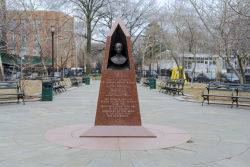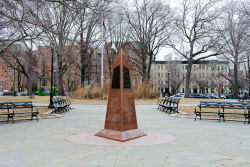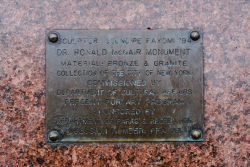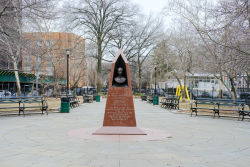Dr. Ronald McNair Park
Dr. Ronald E. McNair Monument
This monument, which combines a traditional bust with a uniquely shaped pedestal, commemorates Dr. Ronald Erwin McNair (1950–1986). He was the African-American astronaut, physicist, teacher, and musician who died aboard the Space Shuttle Challenger when it exploded on January 28, 1986.
Dr. McNair was born on October 21, 1950, in Lake City, South Carolina. He graduated from Carver High School in Lake City in 1967, and received a B.S. degree in physics from North Carolina A & T State University in 1971. In 1976, Dr. McNair completed his Ph.D. in physics at the Massachusetts Institute of Technology (MIT). After graduating from MIT, Dr. McNair was employed as a staff physicist at Hughes Research Laboratories in Malibu, California. His work there involved developing lasers for isotope separation and photochemistry, using non-linear interactions in low-temperature liquids. He also conducted research on electro-optic laser modulation for satellite-to-satellite space communications and explored the scientific foundations of the martial arts. A member of numerous scientific organizations and a visiting lecturer in physics at Texas Southern University, Dr. McNair also taught karate as a fifth-degree black belt and was a performing jazz saxophonist.
In 1978, the National Aeronautics and Space Administration (NASA) selected Dr. McNair as an astronaut candidate. He completed his training the following year, and became eligible as a mission specialist astronaut on Space Shuttle flight crews. He first flew as a mission specialist on Mission STS-41-B on February 3, 1984, which featured the first untethered spacewalk. Serving as a mission specialist on Mission STS-51-L, his life was tragically cut short when the space shuttle exploded one minute and 13 seconds into the launch. After his death, the Dr. Ronald E. McNair Foundation for Science, Technology & Space Education was established in Atlanta, Georgia.
This park, formerly known as Guider Park, was named for Dr. McNair in the same year as the Challenger disaster. The City’s Department of Cultural Affairs sponsored a competition through its Percent-for-Art program to choose an artist to create a central sculpture. They ultimately selected Nigerian-born sculptor Ogundipe Fayomi. Fayomi fashioned a sensitive bronze portrait, set within a nine-foot tall polished red-granite pedestal resembling a modified rocket ship. The pyramidal base features bronze relief with images relating to Dr. McNair’s achievements and interests.
When this monument was dedicated on June 14, 1994, family, friends, former colleagues, community representatives, city officials and hundreds of school children gathered in memory of Dr. McNair’s legacy. The monument and the park, which was renovated at the time of the sculpture’s installation, evoke a mood in keeping with Dr. McNair’s wish inscribed on the pedestal. It reads, “that we should allow this planet to be the beautiful oasis that she is, and allow ourselves to live more in the peace she generates.”
Check out your park's Vital Signs
Clean & Safe
Green & Resilient
Empowered & Engaged Users
Share your feedback or learn more about how this park is part of a
Vital Park System




